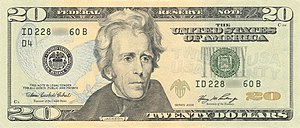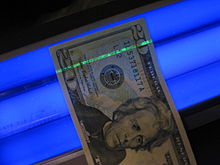United States twenty-dollar bill: Difference between revisions
No edit summary |
|||
| Line 12: | Line 12: | ||
The [[Bureau of Engraving and Printing]] says the "average circulation life" of a $20 bill is 25 months (2 years) before it is replaced due to wear.<ref>{{cite web| title = Circulation Fact Sheet — The New Color of Money: When Will I See It?| publisher =U.S. Bureau of Engraving and Printing| url =http://www.moneyfactory.gov/newmoney/main.cfm/media/circulation| accessdate = 2007-11-20}}</ref> Approximately 22% of all notes printed today are $20 bills. Twenty-dollar bills are delivered by Federal Reserve Banks in violet straps. |
The [[Bureau of Engraving and Printing]] says the "average circulation life" of a $20 bill is 25 months (2 years) before it is replaced due to wear.<ref>{{cite web| title = Circulation Fact Sheet — The New Color of Money: When Will I See It?| publisher =U.S. Bureau of Engraving and Printing| url =http://www.moneyfactory.gov/newmoney/main.cfm/media/circulation| accessdate = 2007-11-20}}</ref> Approximately 22% of all notes printed today are $20 bills. Twenty-dollar bills are delivered by Federal Reserve Banks in violet straps. |
||
Critics of the existing design for the bill have noted that as a general and president, Andrew Jackson took actions that resulted in the mass killing of Native Americans. These critics are concerned that in its current design, the twenty-dollar bill normalizes or legitimates Jackson's role in this history. However, rather than advocating the elimination of the Jackson twenty-dollar bill, these critics have proposed that the bill be redesigned, so that it would bear the text, "ANDREW JACKSON WAS AN INDIAN KILLER," next to Jackson's image. In other words, these critics advocate remembering Jackson's role in American history, rather than eliminating disturbing historical knowledge from the public sphere. |
|||
There are, of course, many others who disagree with these critics and who believe that Jackson remains worthy of a positive commemoration, despite his contributions to the mass killing of Native Americans, as well as his support for the enslavement of human beings whose pigment was unlike his own. |
|||
==Pre-Federal Reserve history== |
==Pre-Federal Reserve history== |
||
Revision as of 18:45, 8 August 2008
 |
 |
The United States twenty-dollar bill ($20) is a denomination of United States currency. U.S. President Andrew Jackson is currently featured on the front side of the bill, while the White House is featured on the reverse side, which is why the twenty-dollar bill is often called a "Jackson".
The twenty-dollar bill in the past was referred to as a "double-sawbuck" because it is twice the value of a ten-dollar bill, which was nicknamed a "sawbuck" due to the resemblance the Roman numeral for ten (X) bears to the legs of a sawbuck, although this usage is far less common today than it was in the early 20th century.[1] The twenty dollar gold coin was known as a "double eagle". Rather than a nickname, this nomenclature was specified by an act of congress.
The twenty-dollar bill is the primary banknote (and in most cases, the only banknote, as it would increase costs to make ATMs compatible with other bills) dispensed by ATMs in the United States as well as the primary bill used for withdrawals or cashing checks. It is, therefore, the highest denomination note most commonly used by Americans on an everyday basis.
The Bureau of Engraving and Printing says the "average circulation life" of a $20 bill is 25 months (2 years) before it is replaced due to wear.[2] Approximately 22% of all notes printed today are $20 bills. Twenty-dollar bills are delivered by Federal Reserve Banks in violet straps.
Critics of the existing design for the bill have noted that as a general and president, Andrew Jackson took actions that resulted in the mass killing of Native Americans. These critics are concerned that in its current design, the twenty-dollar bill normalizes or legitimates Jackson's role in this history. However, rather than advocating the elimination of the Jackson twenty-dollar bill, these critics have proposed that the bill be redesigned, so that it would bear the text, "ANDREW JACKSON WAS AN INDIAN KILLER," next to Jackson's image. In other words, these critics advocate remembering Jackson's role in American history, rather than eliminating disturbing historical knowledge from the public sphere.
There are, of course, many others who disagree with these critics and who believe that Jackson remains worthy of a positive commemoration, despite his contributions to the mass killing of Native Americans, as well as his support for the enslavement of human beings whose pigment was unlike his own.
Pre-Federal Reserve history

- 1861: A demand note with Lady Liberty holding a sword and shield on the front, and an abstract design on the back. The back is printed in green.
- 1862: A note that is very similar, the first $20 United States note. The back is different, with several small variations extant.
- 1863: A gold certificate $20 note with an Eagle vignette on the face. The reverse has a $20 gold coin and various abstract elements. The back is orange.
- 1865: A national bank note with "The Battle of Lexington" and "Columbia Leading a Procession" on either side of the face and obligation text conspicuously in the middle. The reverse features "The Baptism of Pocahontas" in black, and a green border.
- 1869: A new United States note design with Alexander Hamilton on the left side of the front and Victory holding a shield and sword. The back design is green.
- 1875: As above, except with a different reverse.
- 1878: A silver certificate $20 note with a portrait of Stephen Decatur on the right side of the face. The back design is black.
- 1882: A new gold certificate with a portrait of James Garfield on the right of the face. The back is orange and features an eagle.
- 1882: A new national bank note. The front is similar, but the back is different and printed in brown.
- 1886: A new silver certificate $20 note with Daniel Manning on the center of the face.
- 1890: A treasury (coin) note with John Marshall on the left of the face. Two different backs exist: both with abstract designs.
- 1902: A new national bank note. The front design features Hugh McCulloch, and the back has a vignette of an allegorical America.
- 1905: A new gold certificate $20 note with George Washington on the center of the face. The back design is orange.
- 1918: A federal reserve bank note with Grover Cleveland on the front, and a back design similar to the 1914 Federal Reserve Note.
Federal Reserve history





Jackson first appeared on the twenty dollar bill in 1928. It is not clear the reason the bill was switched from Grover Cleveland to Andrew Jackson. According to the U.S. Treasury, "Treasury Department records do not reveal the reason that portraits of these particular statesmen were chosen in preference to those of other persons of equal importance and prominence."[3] The placement of President Andrew Jackson on the $20 bill may be a historical irony; as president, Jackson vehemently opposed both the National Bank and paper money and made the goal of his administration the destruction of the National Bank.[4][5] In his farewell address to the nation, he cautioned the public about paper money.[6]
- 1914: Began as a large-sized note with a portrait of Grover Cleveland on the face, and, on the back, a steam locomotive approaching from the left, and a steamship approaching from the right
- 1928: Switched to a small-sized note with a portrait of Andrew Jackson on the face and the south view of the White House on the reverse. The banknote is redeemable in gold or silver (at the bearer's discretion) at any Federal Reserve Bank.
- 1934: The obligation is changed. The bill is no longer redeemable in gold, but rather in "lawful currency". This is due to the U.S. being taken off of the gold standard. "Lawful currency" in this case means silver.
- 1943: A special emergency series, with brown serial numbers and "HAWAII" overprinted on both the front and the back, is issued. These notes are designed to circulate on the islands, and be deemed invalid in the event of a Japanese invasion.
- 1948: The White House picture was updated to reflect renovations to the building itself as well as the passage of time. Most notably, the trees are larger.
- 1950: Design elements like the serial numbers are reduced in size and moved around subtly, presumably for aesthetic reasons.
- 1963: "Redeemable in Lawful Money" is replaced by "In God We Trust". The two acts (one taking U.S. currency off silver backing, and the other authorizing the national motto) are coincidental, even if their combined result is implemented in one redesign. Also, several design elements are rearranged, less perceptibly than the change in 1950, mostly to make room for the slightly rearranged obligations.
- 1969: The new treasury seal appears on all denominations, including the $20.
- 1977: A new type of serial-number press results in a slightly different font. The old presses are gradually retired, and old-style serial numbers appear as late as 1981 for this denomination.
- 1990: Anti-counterfeiting features are added: microprinting around the portrait, and a plastic strip embedded in the paper.
- September 24, 1998: Received a completely new appearance to further deter counterfeiting; the picture of the White House was changed to the north side view. A larger, off-center portrait of Jackson was used on front, and several anti-counterfeiting features were added, including color-shifting ink, microprinting, and a watermark. The plastic strip now reads "USA 20" and glows green under a black light.
- October 9, 2003[7]: The current series of 20 dollar bills is released with light background shading in green and yellow, and no oval around Andrew Jackson's portrait (background images of eagles, etc. were also added to the front); the back is the same view of the White House, but without the oval around it. Many tiny, faint "20"s are scattered on the back in yellow as a "EURion constellation" to prevent photocopying. The first issue's series date is 2004 with Marin-Snow signatures.
Unmade bills
Several unmade twenty-dollar bills are known. Most are similar in design to the ones described above, with the only difference being certain obligations. For example, a silver-certificate variety of the 1928 style Federal Reserve Note is known in the proof stage, with blue serial numbers. More interesting examples include a 1923 Federal Reserve Note, with Grover Cleveland as on the Series of 1914, but different border elements, an 1873 National Bank note whose design is unknown, and also an 1896 Silver Certificate.
References
- ^ Feldman, David (1990). Who Put the Butter in Butterfly?. New York, N.Y.: Harper & Row, Publishers, Inc. pp. 119–120. ISBN 0-06-091661-3.
- ^ "Circulation Fact Sheet — The New Color of Money: When Will I See It?". U.S. Bureau of Engraving and Printing. Retrieved 2007-11-20.
- ^ "Selection of Portraits and Designs Appearing on Paper Currency". U.S. Bureau of Engraving and Printing. Retrieved 2007-11-20.
- ^ "Jackson as President". CliffsNotes. Retrieved 2007-11-20.
- ^ "Jackson Vetoes Bank Bill — July 10, 1832". Miller Center of Public Affairs, University of Virginia. Retrieved 2007-11-20.
- ^ "JAndrew Jackson's Farewell Address". Wikisource. Retrieved 2007-11-20.
- ^ "Anti-Counterfeiting". Bureau of Engraving and Printing. United States Treasury. 2007. Retrieved 2008-06-11.
See also
- Twenty Bucks, a 1993 movie that follows the travels of a $20 bill
External links
- Mikkelson, Barbara & David P. "How to fold a $20 bill to show images of the September 11 terrorist attacks" at Snopes.com: Urban Legends Reference Pages.
- Burning of notes when microwaved due to presence of metal, not RFID
